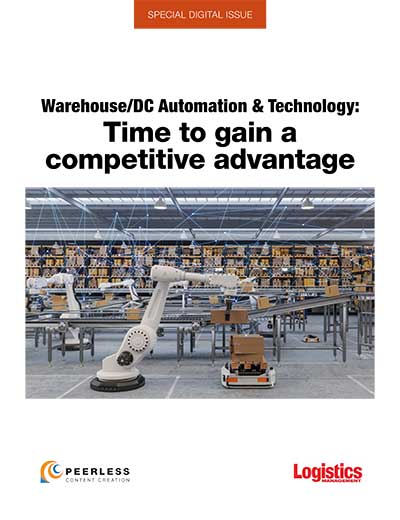JLL research highlights the supply and demand imbalance for industrial real estate space
The ongoing theme of industrial real estate space being in short supply remains fully intact, according to a report issued today by Chicago-based real estate firm JLL.
The report—entitled “The race for industrial space: Can supply keep up?”—focuses on the challenges that industrial real estate stakeholders are up against, at a time when industrial space availability continues to trend down.
“There isn’t a lot of availability in the industrial market, and many tenants are being forced to expand or relocate to secondary and tertiary markets with vacancies at the lowest on record,” the report’s authors noted. “The construction pipeline is robust, with many projects set to deliver in the coming year; however, it is unable to keep up with the rapidly increasing demand, and the backlog of current projects will push anything new out.”
That is made clear, with JLL observing that the pairing of demand from industrial uses and rising demand from traffic-clogged ports has led to near-zero vacancy rates in various urban coastal and urban logistics markets (like Los Angeles and New Jersey) and inland distribution hubs (like Salt Lake City and Columbus) seeing the lowest vacancy levels on record. This has led to a lack of availability for both industrial tenants and developers, as well as increased competition and what JLL called above-average rents, as U.S. industrial rent growth has risen 37% over the past five years.
JLL looked back at how over the last decade, total U.S. industrial inventory headed up 18%, paced by high-population markets, including Chicago, Inland Empire, Dallas-Fort Worth, and Eastern and Central Pennsylvania.
But when the COVID-19 pandemic hit the U.S., in early 2020, it subsequently led to a boom in online shopping, followed by what it called “shockwaves down the supply chain” and an uptick in warehouse demand, with tenants focused on how to prevent an inventory shortage.
“These events were defining moments that shed light on the fact that there is not enough supply to meet rapidly increasing demand in the industrial market,” wrote JLL. “The surge in demand from tenants looking for space to store goods once they’ve left the port increased competition in the overall market, while COVID-related construction delays and material shortages pushed deliveries out and supply trailed behind. As a result, the gap between the amount of space being delivered to lease and the volume of tenant demand grew, resulting in a supply deficit. While deliveries are rebounding from the onset of the pandemic, supply growth is unable to keep pace. Given the heightened demand experienced in 2020 and 2021 and the velocity at which it is going forward, we are starting to see the first wave of a supply crunch.”
This situation, in turn, has created a very challenging outlook for occupiers, said Kelsey Rogers, Manager, Industrial Research, JLL.
“In the short-term we anticipate tight market conditions to continue and with that, rents are expected to rise,” Rogers told LM. “Occupiers will need to be swift and strategic in their decision making to ensure they are able to find space to fit their needs. Prioritizing what is most important to them in terms of location, building age and features, and rent ahead of time will help them quickly find space in the competitive market.”
As for what the ramifications of an industrial real estate space crunch could look like, Rogers explained that they could very well likely throw the market off balance, as markets with exceptionally low vacancies would see rents at record highs, which could push industrial tenants out of the area due to affordability.
The report observed that the average age of industrial product in the U.S. is around 42, due, in large part to pandemic-related restrictions and a lull in new deliveries, with older-generation buildings, defined by JLL as those built more than 20 years ago, represent 75% of total industrial inventory. And these buildings tend to have lower ceiling heights, fewer dock doors, limited trailer parking, and larger footprints, the report said.
But those antiquated buildings are no longer sufficient, with e-commerce, 3PL, and logistics and distribution shippers serving as modern pacesetters, in the form of increased demand and utilization of modern facilities to attract labor and also move goods into and out of facilities at faster rates. And JLL said that in order to meet this demand, new facilities are featuring higher ceiling heights to accommodate mezzanine structures and also higher inventory stacking capabilities, among other features.
Another idea gaining traction cited in the report is the concept of converting underutilized retail, office, and manufacturing sites to logistics usage.
JLL’s Rogers said that the idea of conversions is front and center, especially as we move into the post pandemic world.
“Many property types are finding new life as last mile facilities, with users focusing more on location rather than building use,” she said. “While JLL Research has seen the initiation of several conversion projects it is not yet a widespread practice. Some of the biggest hurdles in getting conversions done include economic, political, physical, and legal factors. However, as the need for last mile facilities continues to grow, we anticipate current projects will highlight the benefits of these facilities as the highest and best use for a location, encouraging the adoption for the much-demanded space.”
Looking ahead, JLL made a few observations about what could be in store, including:
- with heightened rent growth and record-low vacancy on the horizon, JLL Research forecasting models predict rents will rise by more than 8% and accelerated by year-end;
- with continuing tightening in the market, vacancy rates are expected to stay below the 4% threshold; and
- the supply and demand imbalance will continue through 2023 and further exacerbate the race for space












